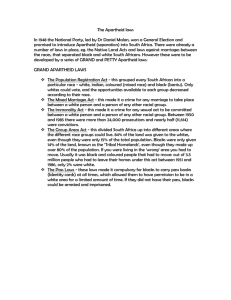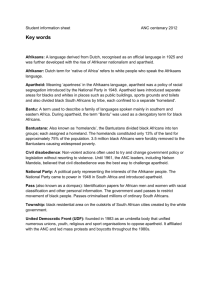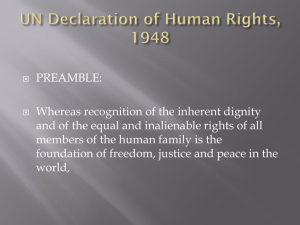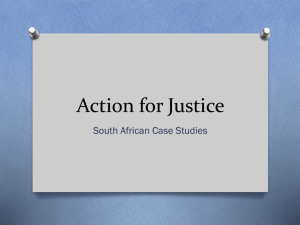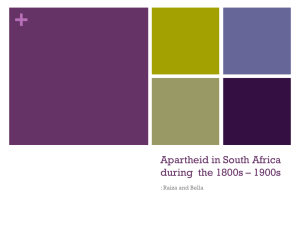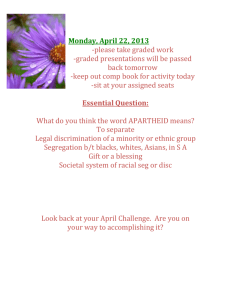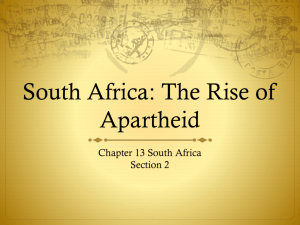South Africa and Apartheid Legislation Notes
advertisement
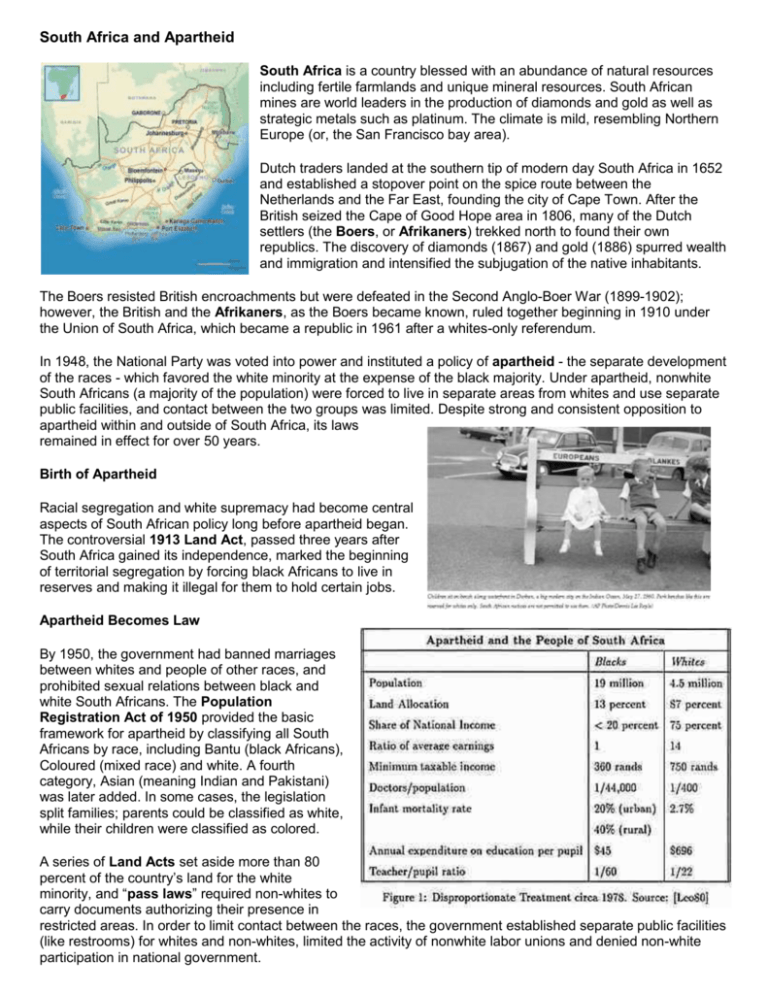
South Africa and Apartheid South Africa is a country blessed with an abundance of natural resources including fertile farmlands and unique mineral resources. South African mines are world leaders in the production of diamonds and gold as well as strategic metals such as platinum. The climate is mild, resembling Northern Europe (or, the San Francisco bay area). Dutch traders landed at the southern tip of modern day South Africa in 1652 and established a stopover point on the spice route between the Netherlands and the Far East, founding the city of Cape Town. After the British seized the Cape of Good Hope area in 1806, many of the Dutch settlers (the Boers, or Afrikaners) trekked north to found their own republics. The discovery of diamonds (1867) and gold (1886) spurred wealth and immigration and intensified the subjugation of the native inhabitants. The Boers resisted British encroachments but were defeated in the Second Anglo-Boer War (1899-1902); however, the British and the Afrikaners, as the Boers became known, ruled together beginning in 1910 under the Union of South Africa, which became a republic in 1961 after a whites-only referendum. In 1948, the National Party was voted into power and instituted a policy of apartheid - the separate development of the races - which favored the white minority at the expense of the black majority. Under apartheid, nonwhite South Africans (a majority of the population) were forced to live in separate areas from whites and use separate public facilities, and contact between the two groups was limited. Despite strong and consistent opposition to apartheid within and outside of South Africa, its laws remained in effect for over 50 years. Birth of Apartheid Racial segregation and white supremacy had become central aspects of South African policy long before apartheid began. The controversial 1913 Land Act, passed three years after South Africa gained its independence, marked the beginning of territorial segregation by forcing black Africans to live in reserves and making it illegal for them to hold certain jobs. Apartheid Becomes Law By 1950, the government had banned marriages between whites and people of other races, and prohibited sexual relations between black and white South Africans. The Population Registration Act of 1950 provided the basic framework for apartheid by classifying all South Africans by race, including Bantu (black Africans), Coloured (mixed race) and white. A fourth category, Asian (meaning Indian and Pakistani) was later added. In some cases, the legislation split families; parents could be classified as white, while their children were classified as colored. A series of Land Acts set aside more than 80 percent of the country’s land for the white minority, and “pass laws” required non-whites to carry documents authorizing their presence in restricted areas. In order to limit contact between the races, the government established separate public facilities (like restrooms) for whites and non-whites, limited the activity of nonwhite labor unions and denied non-white participation in national government. Apartheid and Separate Development Dr. Hendrik Verwoerd, who became prime minister in 1958, refined apartheid policy further into a system he referred to as “separate development.” The Promotion of Bantu Self-Government Act of 1959 created 10 Bantu homelands known as Bantustans. Separating black South Africans from each other enabled the government to claim there was no black majority, and reduced the possibility that blacks would unify into one nationalist organization. Every black South African was designated as a citizen as one of the Bantustans, a system that supposedly gave them full political rights, but effectively removed them from the nation’s political body. In one of the most devastating aspects of apartheid, the government forcibly removed black South Africans from rural areas designated as “white” to the homelands, and sold their land at low prices to white farmers. From 1961 to 1994, more than 3.5 million people were forcibly removed from their homes and deposited in the Bantustans, where they were plunged into poverty. Apartheid Legislation in South Africa What makes South Africa's apartheid era different to segregation and racial hatred that have occurred in other countries is the systematic way in which the National Party, which came into power in 1948, formalized it through the law. The main laws are described below. Questions: in your notes, answer the following questions. 1. Choose the Three (3) laws that would anger or humiliate you the most. Explain why. 2. Choose three (3) laws and explain what you think the purpose of each law is. (Why would the government make these specific laws? What are they trying to accomplish?) Prohibition of Mixed Marriages Act, Act No 55 of 1949 Prohibited marriages between white people and people of other races. Population Registration Act, Act No 30 of 1950 Introduced an identity card for all persons over the age of eighteen, specifying their racial group. A Race Classification Board took the final decision on what a person's race was in disputed cases. Group Areas Act, Act No 41 of 1950 Forced physical separation between races by creating different residential areas for different races. Led to forced removals of people living in "wrong" areas, established Black “Townships”. Suppression of Communism Act, Act No 44 of 1950 Outlawed communism in South Africa. Communism was defined so broadly that it covered any call for change. Communists could be banned from participating in a political organization and restricted to a particular area. Bantu Building Workers Act, Act No 27 of 1951 Made it a criminal offence for a black person to perform any skilled work in urban areas except in those occupations designated for black occupation. Separate Representation of Voters Act, Act No 46 of 1951 This act led to non-whites being unable to vote in national elections. Pass Laws: Act, Act No 67 of 1952 Commonly known as the Pass Laws, this act forced black people to carry identification with them at all times. A pass included a photograph, details of place of origin, employment record, tax payments, and encounters with the police. It was a criminal offence to be unable to produce a pass when required to do so by the police. No black person could leave a rural area for an urban one without a permit from the local authorities. Bantu Education Act, Act No 47 of 1953 Established a Black Education Department which would compile a separate curriculum that suited the "nature and requirements of the black people". The author of the legislation, Dr Hendrik Verwoerd, stated that its aim was to prevent Africans receiving an education that would lead them to aspire to positions they wouldn't be allowed to hold in society. Instead Africans were to receive an education designed to provide them with skills to serve their own people in the homelands or to work in laboring jobs under whites. Reservation of Separate Amenities Act, Act No 49 of 1953 Forced segregation in all public restrooms, public buildings, and public transportation with the aim of eliminating contact between whites and other races. "Europeans Only" and "Non-Europeans Only" signs were put up. The act stated that facilities provided for different races need not be equal. Natives (Prohibition of Interdicts) Act, Act No 64 of 1956 Denied black people the option of appealing to the courts against forced removals. Extension of University Education Act, Act 45 of 1959 Put an end to black students attending white universities (mainly the universities of Cape Town and Witwatersrand). Created separate universities for whites, Coloured, blacks, and Asians. Terrorism Act of 1967 Allowed for sending Africans to jail without trial for 90 days. Established BOSS, the Bureau of State Security, which was responsible for the internal security of South Africa. Bantu Homelands Citizens Act of 1970 Compelled all black people to become a citizen of the homeland that responded to their ethnic group, regardless of whether they'd ever lived there or not, and removed their South African citizenship. Black Africans are no longer citizens of South Africa.
